Montevideo(Uruguay) 作者: 来源: 发布时间:2021-06-03
1.Population and Area
Montevideo is the capital and largest city of Uruguay. According to the 2011 census, the city proper has a population of 1,319,108 (about one-third of the country's total population) in an area of 201 square kilometres (78 sq mi). The southernmost capital city in the Americas, Montevideo is situated on the southern coast of the country, on the northeastern bank of the Río de la Plata.
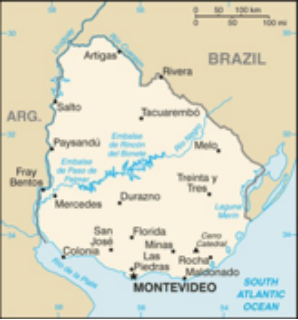
2. Geography
Montevideo is situated on the north shore of the Río de la Plata, the arm of the Atlantic Ocean that separates the south coast of Uruguay from the north coast of Argentina; Buenos Aires lies 230 kilometres (140 mi) west on the Argentine side. The Santa Lucía River forms a natural border between Montevideo and San José Department to its west. To the city's north and east is Canelones Department, with the stream of Carrasco forming the eastern natural border. The coastline forming the city's southern border is interspersed with rocky protrusions and sandy beaches. The Bay of Montevideo forms a natural harbour, the nation's largest and one of the largest in the Southern Cone, and the finest natural port in the region, functioning as a crucial component of the Uruguayan economy and foreign trade. Various streams criss-cross the town and empty into the Bay of Montevideo. Its coastline near the emptying rivers are heavily polluted.
The city has an average elevation of 43 metres (141 ft). Its highest elevations are two hills: the Cerro de Montevideo and the Cerro de la Victoria, with the highest point, the peak of Cerro de Montevideo, crowned by a fortress, the Fortaleza del Cerro at a height of 134 m (440 ft).
Montevideo enjoys a humid subtropical climate (Cfa, according to the Köppen climate classification). The city has cool winters (June to September), warm-hot summers (December to March) and volatile springs (October and November); there are numerous thunderstorms but no tropical cyclones. Rainfall is regular and evenly spread throughout the year, reaching around 950 millimetres (37 in).
Winters are generally cool, wet, windy and overcast. During this season, there are bursts of icy and relatively dry winds of continental polar air masses, giving an unpleasant chilly feeling to the everyday life of the city. Frosts occur few times during winter, generally not falling below 28° F (-2° C) because of the oceanic influence that moderates the temperature; few miles away from the coast, frosts are more common and colder. Rainfall and sleet are a frequent winter occurrence, but snowfall is extremely rare: flurries have been recorded only four times but with no accumulation, the last one on 13 July 1930 during the inaugural match of the World Cup, (the other three snowfalls were in 1850, 1853 and 1917); the alleged 1980 Carrasco snowfall was actually a hailstorm.
Summers are warm-hot and humid, with less wind than other seasons. During this season, a moderate wind often blows from the sea in the evenings which has a pleasant cooling effect on the city, in contrast to the more-severe summer heat of nearby cities like Buenos Aires. Heat waves come with the north winds, which bring humid and hot air masses from the tropical interior of the continent. These warm periods are usually followed by thunderstorms, generated by cold fronts of the southwest that lowers temperatures considerably. This phenomenon is regional, and can occur several times all year long.
3. Economy
As of 2010, Montevideo was the 19th largest city economy in the continent and 9th highest income earner among major cities. In 2020, it has a projected GDP of $49.7 billion, with a per capita of $28,385.
As the capital of Uruguay, Montevideo is the economic and political centre of the country. Most of the largest and wealthiest businesses in Uruguay have their headquarters in the city. Since the 1990s the city has undergone rapid economic development and modernization, including two of Uruguay's most important buildings—the World Trade Center Montevideo (1998), and Telecommunications Tower (2000), the headquarters of Uruguay's government-owned telecommunications company ANTEL, increasing the city's integration into the global marketplace.
The Port of Montevideo, in the northern part of Ciudad Vieja, is one of the major ports of South America and plays a very important role in the city's economy.The port has been growing rapidly and consistently at an average annual rate of 14 percent due to an increase in foreign trade. The city has received a US$20 million loan from the Inter-American Development Bank to modernize the port, increase its size and efficiency, and enable lower maritime and river transportation costs.
Banking has traditionally been one of the strongest service export sectors in Uruguay: the country was once dubbed "the Switzerland of America", mainly for its banking sector and stability, although that stability has been threatened in the 21st century by the recent global economic climate. The largest bank in Uruguay is Banco Republica (BROU), based in Montevideo. Almost 20 private banks, most of them branches of international banks, operate in the country (Banco Santander, BBVA, ABN AMRO, Citibank, among others). There are also a myriad of brokers and financial-services bureaus, among them Ficus Capital, Galfin Sociedad de Bolsa, Europa Sociedad de Bolsa, Darío Cukier, GBU, Hordeñana & Asociados Sociedad de Bolsa, etc.
Turismo: Tourism accounts for much of Uruguay's economy. Tourism in Montevideo is centered in the Ciudad Vieja area, which includes the city's oldest buildings, several museums, art galleries, and nightclubs, with Sarandí Street and the Mercado del Puerto being the most frequented venues of the old city.On the edge of Ciudad Vieja, Plaza Independencia is surrounded by many sights, including the Solís Theatre and the Palacio Salvo; the plaza also constitutes one end of 18 de Julio Avenue, the city's most important tourist destination outside of Ciudad Vieja. Apart from being a shopping street, the avenue is noted for its Art Decobuildings, three important public squares, the Gaucho Museum, the Palacio Municipal and many other sights. The avenue leads to the Obelisk of Montevideo; beyond that is Parque Batlle, which along with the Parque Prado is another important tourist destination. Along the coast, the Fortaleza del Cerro, the Rambla (the coastal avenue), 13 kilometres (8.1 mi) of sandy beaches, and Punta Gorda attract many tourists, as do the Barrio Sur and Palermo barrios.
The Ministry of Tourism offers a two-and-a-half-hour city tour and the Montevideo Tourist Guide Association offers guided tours in English, Italian, Portuguese and German. Apart from these, many private companies offer organized city tours.
Most tourists to the city come from Argentina, Brazil and Europe, with the number of visitors from elsewhere in Latin America and from the United States growing every year, thanks to an increasing number of international airline arrivals at Carrasco International Airport as well as cruises that arrive into the port of Montevideo.
4. Industry
The most important state-owned companies headquartered in Montevideo are: AFE (railways), ANCAP (Energy), Administracion Nacional de Puertos (Ports), ANTEL (telecommunications), BHU (savings and loan), BROU (bank), BSE (insurance), OSE (water & sewage), UTE (electricity). These companies operate under public law, using a legal entity defined in the Uruguayan Constitution called Ente Autonomo ("autonomous entity"). The government also owns part of other companies operating under private law, such as those owned wholly or partially by the CND (National Development Corporation).
5. Landmarks
The architecture of Montevideo ranges from Neoclassical buildings such as the Montevideo Metropolitan Cathedral to the Postmodern style of the World Trade Center Montevideo or the 158-metre (518 ft) ANTEL Telecommunication Tower, the tallest skyscraper in the country. Along with the Telecommunications Tower, the Palacio Salvo dominates the skyline of the Bay of Montevideo. The building facades in the Old Town reflect the city's extensive European immigration, displaying the influence of old European architecture. Notable government buildings include the Legislative Palace, the City Hall, Estévez Palace and the Executive Tower. The most notable sports stadium is the Estadio Centenario within Parque Batlle. Parque Batlle, Parque Rodó and Parque Prado are Montevideo's three great parks.
The Pocitos district, near the beach of the same name, has many homes built by Bello and Reboratti between 1920 and 1940, with a mixture of styles. Other landmarks in Pocitos are the "Edificio Panamericano" designed by Raul Sichero, and the "Positano" and "El Pilar" designed by Adolfo Sommer Smith and Luis García Pardo in the 1950s and 1960s. However, the construction boom of the 1970s and 1980s transformed the face of this neighbourhood, with a cluster of modern apartment buildings for upper and upper middle class residents.
Palacio Legislativo
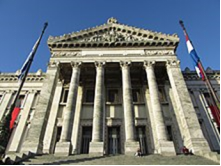
The Palacio Legislativo in Aguada, the north of the city centre, is currently the seat of the Uruguayan Parliament. Construction started in 1904 and was sponsored by the government of President José Batlle y Ordóñez. It was designed by Italian architects Vittorio Meano and Gaetano Moretti, who planned the building's interior. Among the notable contributors to the project was sculptor José Belloni, who contributed numerous reliefs and allegorical sculptures.
World Trade Center Montevideo
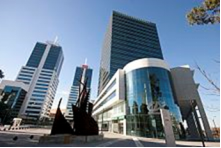
World Trade Center Montevideo officially opened in 1998, but work was completed in 2009. The complex is composed of three towers, two three-story buildings called World Trade Center Plaza and World Trade Center Avenue and a large central square called Towers Square. World Trade Center 1 was the first building to be inaugurated, in 1998. It has 22 floors and 17,100 square metres of space. That same year the avenue and the auditorium were raised. World Trade Center 2 was inaugurated in 2002, a twin tower of World Trade Center 1. Finally, in 2009, World Trade Center 3 and the World Trade Center Plaza and the Towers Square were inaugurated. It is located between the avenues Luis Alberto de Herrera and 26 de Marzo and has 19 floors and 27,000 square metres (290,000 sq ft) of space. The 6,300-square-metre (68,000 sq ft) World Trade Center Plaza is designed to be a centre of gastronomy opposite Towers Square and Bonavita St. Among the establishments on the plaza are Burger King, Walrus, Bamboo, Asia de Cuba, Gardenia Mvd, and La Claraboya Cafe.
The Towers Square, is an area of remarkable aesthetic design, intended to be a platform for the development of business activities, art exhibitions, dance and music performances and social place. This square connects the different buildings and towers which comprise the WTC Complex and it is the main access to the complex. The square contains various works of art, notably a sculpture by renowned Uruguayan sculptor Pablo Atchugarry. World Trade Center 4, with 40 floors and 53,500 square metres (576,000 sq ft) of space is under construction as of 2010.
Telecommunications Tower
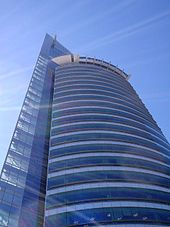
Torre de las Telecomunicaciones (Telecommunications Tower) or Torre Antel (Antel Tower) is the 158 metres (518 ft), 37-floor headquarters of Uruguay's government-owned telecommunications company, ANTEL, and is the tallest building in the country. It was designed by architect Carlos Ott. It is situated by the side of the Bay of Montevideo. The tower was completed by American Bridge and other design/build consortium team members on 15 March 2000.
When its construction was announced, many politicians complained about its cost (US$40 million, plus US$25 million for the construction of the other 5 buildings of the Telecommunications Complex). Problems during its construction turned the original US$65 million price into US$102 million.
Ciudad Vieja (Old City)
Ciudad Vieja was the earliest part of the city to be developed and today it constitutes a prominent barrio of southwest Montevideo. It contains many colonial buildings and national heritage sites, but also many banks, administrative offices, museums, art galleries, cultural institutions, restaurants and night-clubs, making it vibrant with life. Its northern coast is the main port of Uruguay, one of the few deep-draft ports in the Southern Cone of South America.
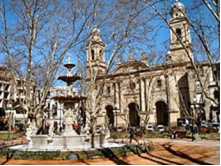
Plaza de la Constitución in winter
Montevideo's most important plaza is Plaza Independencia, located between Ciudad Vieja and downtown Montevideo. It starts with the Gateway of The Citadel at one end and ends at the beginning of 18 de Julio Avenue. It is the remaining part of the wall that surrounded the oldest part of the city.[70]Several notable buildings are located here.
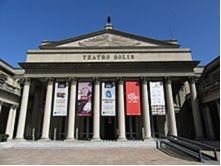
Solís Theatre
The Solís Theatre is Uruguay's oldest theatre. It was built in 1856 and is currently owned by the government of Montevideo. In 1998, the government of Montevideo started a major reconstruction of the theatre, which included two US$110,000 columns designed by Philippe Starck. The reconstruction was completed in 2004, and the theatre reopened in August of that year. The plaza is also the site of the offices of the President of Uruguay (both the Estévez Palaceand the Executive Tower). The Artigas Mausoleum is located at the centre of the plaza. Statues include that of José Gervasio Artigas, hero of Uruguay's independence movement; an honour guard keeps vigil at the Mausoleum.
Palacio Salvo, at the intersection of 18 de Julio Avenue and Plaza Independencia, was designed by the architect Mario Palanti and completed in 1925. Palanti, an Italian immigrant living in Buenos Aires, used a similar design for his Palacio Barolo in Buenos Aires, Argentina. Palacio Salvo stands 100 metres (330 ft) high, including its antenna. It is built on the former site of the Confitería La Giralda, renowned for being where Gerardo Matos Rodríguez wrote his tango "La Cumparsita" (1917.) Palacio Salvo was originally intended to function as a hotel but is now a mixture of offices and private residences.
Also of major note in Ciudad Vieja is the Plaza de la Constitución (or Plaza Matriz). During the first decades of Uruguayan independence this square was the main hub of city life. On the square are the Cabildo—the seat of colonial government—and the Montevideo Metropolitan Cathedral. The cathedral is the burial place of Fructuoso Rivera, Juan Antonio Lavalleja and Venancio Flores. Another notable square is Plaza Zabala with the equestrian statue of Bruno Mauricio de Zabala. On its south side, Palacio Taranco, once residence of the Ortiz Taranco brothers, is now the Museum of Decorative Arts. A few blocks northwest of Plaza Zabala is the Mercado del Puerto, another major tourist destination.
Parque Batlle
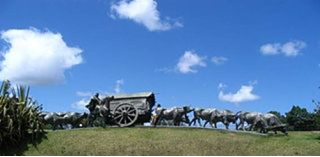
Monumento La Carreta
Parque Batlle (formerly: Parque de los Aliados, translation: "Park of the Allies") is a major public central park, located south of Avenida Italia and north of Avenue Rivera. Along with Parque Prado and Parque Rodó it is one of three large parks that dominate Montevideo. The park and surrounding area constitute one of the 62 neighbourhoods (barrios) of the city. The barrio of Parque Batlle is one of seven coastal barrios, the others being Buceo, Carrasco, Malvin, Pocitos, Punta Carretas, and Punta Gorda. The current barrio of Parque Battle includes four former districts: Belgrano, Italiano, Villa Dolores and Batlle Park itself and borders the neighbourhoods of La Blanqueada, Tres Cruces, Pocitos and Buceo. It has a high population density and most of its households are of medium-high- or high-income. Villa Dolores, a subdistrict of Parque Batlle, took its name from the original villa of Don Alejo Rossell y Rius and of Doña Dolores Pereira de Rossel. On their grounds, they started a private collection of animals that became a zoological garden and was passed to the city in 1919; in 1955 the Planetarium of Montevideo was built within its premises.
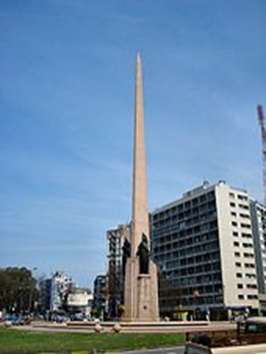
Obelisk of Montevideo in the Parque Batlle
Parque Batlle is named in honour of José Batlle y Ordóñez, President of Uruguay from 1911 to 1915. The park was originally proposed by an Act of March 1907, which also projected wide boulevards and avenues. French landscape architect, Carlos Thays, began the plantings in 1911. In 1918, the park was named Parque de los Aliados, following the victory of the Allies of World War I. On 5 May 1930, after significant expansion, it was again renamed as Parque Batlle y Ordóñez, in memory of the prominent politician and president, who had died in 1929. The park was designated a National Historic Monument Park in 1975. As of 2010, the park covers an area of 60 hectares (150 acres) and is considered the "lung" of the Montevideo city due to the large variety of trees planted here.
The Estadio Centenario, the national football stadium, opened in 1930 for the first World Cup, and later hosted several other sporting grounds of note (see Sports).
In 1934, sculptor José Belloni's "La Carreta", a bronze monument on granite base, was installed on Avenida Lorenzo Merola near Estadio Centenario. One of several statues in the park, it depicts yoked oxen pulling a loaded wagon. It was designated a national monument in 1976. Another statue on the same side of the park is a bronze copy of the Discobolus of Myron.
On the west side of Parque Batlle, on Artigas Boulevard, the 1938 Obelisk of Montevideo is a monument dedicated to those who created the first Constitution. The work of sculptor José Luis Zorrilla de San Martín (1891–1975), it is a three-sided granite obelisk, 40 metres (130 ft) tall, with bronze statues on its three sides, representing "Law", "Liberty", and "Force", respectively. It has been a National Heritage Site since 1976.
Parque Prado
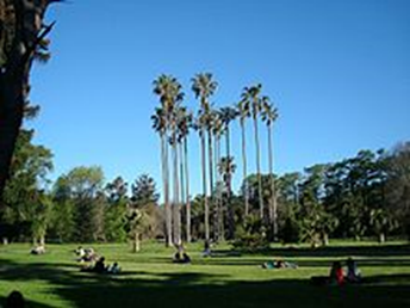
The Botanic Gardens of Parque Prado
Established in 1873, the largest of Montevideo's six main public parks is the 1.06-square-kilometre (260-acre) Parque Prado. Located in the northern part of the city, the Miguelete Creek flows through the park and the neighbourhood and of the same name. It is surrounded by the avenues Agraciada, Obes Lucas, Joaquín Suárez, Luis Alberto de Herrera and by the streets Castro and José María Reyes.
The most frequented areas of the park are the Rosedal, a public rose garden with pergolas, the Botanical Garden, the area around the Hotel del Prado, as well as the Rural del Prado, a seasonal cattle and farm animal fairground. The Rosedal contains four pergolas, eight domes, and a fountain; its 12,000 roses were imported from France in 1910. There are several jogging paths along the Miguelete river.
The Presidential Residence is located behind the Botanical Gardens. Established in 1930, Juan Manuel Blanes Museum is situated in the Palladian villa, a National Heritage Site since 1975, and includes a Japanese garden. The Professor Atilio Lombardo Museum and Botanical Gardens were established in 1902. The National Institute of Physical Climatology and its observatory are also in the Prado.
Parque Rodó
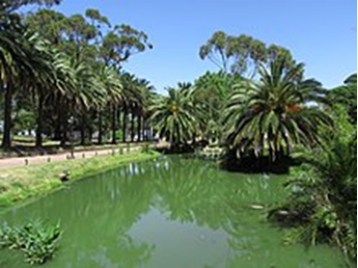
Parque Rodó.
Parque Rodó is both a barrio (neighbourhood) of Montevideo and a park which lies mostly outside the limits of the neighbourhood itself and belongs to Punta Carretas. The name "Rodó" commemorates José Enrique Rodó, an important Uruguayan writer whose monument is in the southern side of the main park. The park was conceived as a French-style city park. Apart from the main park area which is delimited by Sarmiento Avenue to the south, Parque Rodó includes an amusement park; the Estadio Luis Franzini, belonging to Defensor Sporting; the front lawn of the Faculty of Engineering and a strip west of the Club de Golf de Punta Carretas that includes the Canteras ("quarry") del Parque Rodó, the Teatro de Verano ("summer theatre") and the Lago ("lake") del Parque Rodó.
On the east side of the main park area is the National Museum of Visual Arts. On this side, a street market takes place every Sunday. On the north side is an artificial lake with a little castle housing a municipal library for children. An area to its west is used as an open-air exhibition of photography. West of the park, across the coastal avenue Rambla Presidente Wilson, stretches Ramirez Beach. Directly west of the main park are, and belonging to Parque Rodó barrio, is the former Parque Hotel, now called Edifício Mercosur, seat of the parliament of the members countries of the Mercosur. During the guerilla war the Tupamaros frequently attacked buildings in this area, including the old hotel.
Forts
The first set of subsidiary forts were planned by the Portuguese at Montevideo in 1701 to establish a front line base to stop frequent insurrections by the Spaniards emanating from Buenos Aires. These fortifications were planned within the River Plate estuary at Colonia del Sacramento. However, this plan came to fruition only in November 1723, when Captain Manuel Henriques de Noronha reached the shores of Montevideo with soldiers, guns and colonists on his warship Nossa Senhora de Oliveara. They built a small square fortification. However, under siege from forces from Buenos Aires, the Portuguese withdrew from Montevideo Bay in January 1724, after signing an agreement with the Spaniards.
Fortaleza del Cerro (Fortress del Cerro)
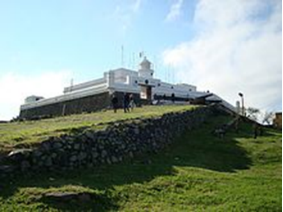
Fortaleza del Cerro
Fortaleza del Cerro overlooks the bay of Montevideo. An observation post at this location was first built by the Spanish in the late 18th century. In 1802, a beacon replaced the observation post; construction of the fortress began in 1809 and was completed in 1839. It has been involved in many historical developments and has been repeatedly taken over by various sides. In 1907, the old beacon was replaced with a stronger electric one. It has been a National Monument since 1931 and has housed a military museum since 1916. Today it is one of the tourist attractions of Montevideo.
Punta Brava Lighthouse
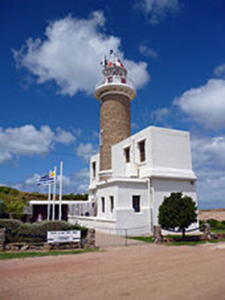
Punta Brava lighthouse.
Punta Brava Lighthouse (Faro Punta Brava), also known as Punta Carretas Lighthouse, was erected in 1876. The lighthouse is 21 metres (69 ft) high and its light reaches 24 km (15 mi) away, with a flash every ten seconds. In 1962, the lighthouse became electric. The lighthouse is important for guiding boats into the Banco Inglés Buceo Port or the entrance of the Santa Lucía River.
Rambla of Montevideo
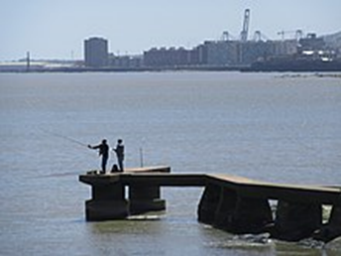
Fishermen in Punta Carretas.
The Rambla is an avenue that goes along the entire coastline of Montevideo. The literal meaning of the Spanish word rambla is "avenue" or "watercourse", but in the Americas it is mostly used as "coastal avenue", and since all the southern departments of Uruguay border either the Río de la Plata or the Atlantic Ocean, they all have ramblas as well. As an integral part of Montevidean identity, the Rambla has been included by Uruguay in the Indicative List of World Heritage sites,[99] though it has not received this status. Previously, the entire Rambla was called Rambla Naciones Unidas ("United Nations"), but in recent times different names have been given to specific parts of it.
The Rambla is a very important site for recreation and leisure in Montevideo. Every day, a large number of people go there to take long strolls, jog, bicycle, roller skate, fish and even—in a special area—skateboard. Its 27-kilometre (17 mi) length makes it one of the longest esplanades in the world.
Montevideo is noted for its beaches, which are particularly important because 60% of the population spends the summer in the city. Its best known beaches are Ramírez, Pocitos, Carrasco, Buceo and Malvín. Further east and west are other beaches including the Colorada, Punta Espinillo, Punta Yeguas, Zabala and Santa Catarina.
Cemeteries
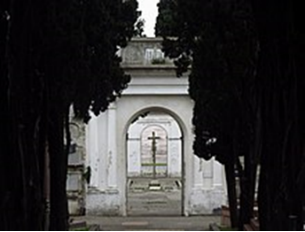
Central Cemetery.
There are five large cemeteries in Montevideo, all administered by the "Fúnebre y Necrópolis" annex of the Intendencia of Montevideo.
The largest cemetery is the Cementerio del Norte, located in the northern-central part of the city. The Central Cemetery (Spanish: Cementerio central), located in Barrio Sur in the southern area of the city, is one of Uruguay's main cemeteries. It was one of the first cemeteries (in contrast to church graveyards) in the country, founded in 1835 in a time where burials were still carried out by the Catholic Church. It is the burial place of many of the most famous Uruguayans, such as Eduardo Acevedo, Delmira Agustini, Luis Batlle Berres, José Batlle y Ordóñez, Juan Manuel Blanes, François Ducasse, father of Comte de Lautréamont (Isidore Ducasse), Luis Alberto de Herrera, Benito Nardone, José Enrique Rodó, and Juan Zorrilla de San Martín.
The other large cemeteries are the Cementerio del Buceo, Cementerio del Cerro, and Cementerio Paso Molino. The British Cemetery Montevideo (Cementerio Británico) is another of the oldest cemeteries in Uruguay, located in the Buceo neighborhood. Many noblemenand eminent persons are buried there. The cemetery originated when the Englishman Mr. Thomas Samuel Hood purchased a plot of land in the name of the English residents in 1828. However, in 1884 the government compensated the British by moving the cemetery to Buceo to accommodate city growth. A section of the cemetery, known as British Cemetery Montevideo Soldiers and Sailors, contains the graves of quite a number of sailors of different nationalities, although the majority are of British descent. One United States Marine, Henry de Costa, is buried here.
6. Culture And history
History:The city was established in 1724 by a Spanish soldier, Bruno Mauricio de Zabala, as a strategic move amidst the Spanish-Portuguese dispute over the platine region. It was also under brief British rule in 1807. Montevideo is the seat of the administrative headquarters of Mercosur and ALADI, Latin America's leading trade blocs, a position that entailed comparisons to the role of Brussels in Europe.
Festivals
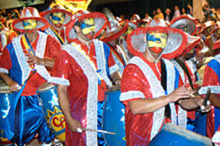
Montevideo Carnival: drummers "Zonal queens"
As the capital of Uruguay, Montevideo is home to a number of festivals and carnivals including a Gaucho festival when people ride through the streets on horseback in traditional gaucho gear. The major annual festival is the annual Montevideo Carnival which is part of the national festival of Carnival Week, celebrated throughout Uruguay, with central activities in the capital, Montevideo. Officially, the public holiday lasts for two days on Carnival Monday and Shrove Tuesday preceding Ash Wednesday, but due to the prominence of the festival, most shops and businesses close for the entire week. During carnival there are many open-air stage performances and competitions and the streets and houses are vibrantly decorated. "Tablados" or popular scenes, both fixed and movable, are erected in the whole city. Notable displays include "Desfile de las Llamadas" ("Parade of the Calls"), which is a grand united parade held on the south part of downtown, where it used to be a common ritual back in the early 20th century. Due to the scale of the festival, preparation begins as early as December with an election of the "zonal beauty queens" to appear in the carnival.
7. Other information
The 2019 Mercer's report on quality of life, rated Montevideo first in Latin America, a rank the city has consistently held since 2005.
In 2018, it was classified as a beta global city ranking eighth in Latin America and 84th in the world. Montevideo hosted every match during the first FIFA World Cup, in 1930. Described as a "vibrant, eclectic place with a rich cultural life", and "a thriving tech center and entrepreneurial culture", Montevideo ranked eighth in Latin America on the 2013 MasterCard Global Destination Cities Index.
In 2014, it was also regarded as the fifth most gay-friendly metropolis in the world and the first in Latin America. It is the hub of commerce and higher education in Uruguay as well as its chief port. The city is also the financial hub of Uruguay and the cultural anchor of a metropolitan area with a population of around 2 million.
8. Contact
Address: Av.18 de Julio 1360 - Montevideo, Uruguay. C.P. 11200
Tel: 1950 2110
E-mail: secintendente@imm.gub.uy
Fax: 2902 0201
Intendant: Christian di Candia
Website: https://montevideo.gub.uy/
